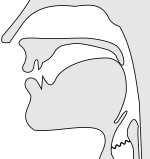| Voiced uvular nasal | |||
|---|---|---|---|
| ɴ | |||
| IPA number | 120 | ||
| Audio sample | |||
| source · help | |||
| Encoding | |||
| Entity (decimal) | ɴ | ||
| Unicode (hex) | U+0274 | ||
| X-SAMPA | N\ | ||
| Braille | |||
| |||
The voiced uvular nasal is a type of consonantal sound, used in some spoken languages. The symbol in the International Phonetic Alphabet that represents this sound is ⟨ɴ⟩, a small capital version of the Latin letter n; the equivalent X-SAMPA symbol is N\.
The uvular nasal is a rare sound cross-linguistically, occurring as a phoneme in only a small handful of languages. It is complex in terms of articulation, and also highly marked, as it is inherently difficult to produce a nasal articulation at the uvular point of contact. This difficulty can be said to account for the marked rarity of this sound among the world's languages.
The uvular nasal most commonly occurs as a conditioned allophone of other sounds, for example as an allophone of /n/ before a uvular plosive as in Quechua, or as an allophone of /q/ before another nasal consonant as in Selkup. However, it has been reported to exist as an independent phoneme in a small number of languages. Examples include the Klallam language, Tagalog language, the Tawellemmet and Ayr varieties of Tuareg Berber, the Rangakha dialect of Khams Tibetan, at least two dialects of the Bai language, the Papuan language Mapos Buang, and the Chamdo languages: Lamo (Kyilwa dialect), Larong sMar (Tangre Chaya dialect), Drag-yab sMar (Razi dialect). In Mapos Buang and in the Bai dialects, it contrasts phonemically with a velar nasal. In the Chamdo languages it contrasts phonemically with /ŋ/, /ŋ̊/, and /ɴ̥/. The syllable-final nasal in Japanese was traditionally said to be realized as a uvular nasal when utterance-final, but empirical studies have disputed this claim.
There is also the pre-uvular nasal in some languages such as Yanyuwa, which is articulated slightly more front compared with the place of articulation of the prototypical uvular nasal, though not as front as the prototypical velar nasal. The International Phonetic Alphabet does not have a separate symbol for that sound, though it can be transcribed as ⟨ɴ̟⟩ (advanced ⟨ɴ⟩), ⟨ŋ̠⟩ or ⟨ŋ˗⟩ (both symbols denote a retracted ⟨ŋ⟩). The equivalent X-SAMPA symbols are N\_+ and N_-, respectively.
Features
Features of the voiced uvular nasal:
- Its manner of articulation is occlusive, which means it is produced by obstructing airflow in the vocal tract. Because the consonant is also nasal, the blocked airflow is redirected through the nose.
- Its place of articulation is uvular, which means it is articulated with the back of the tongue (the dorsum) at the uvula.
- Its phonation is voiced, which means the vocal cords vibrate during the articulation.
- It is a nasal consonant, which means air is allowed to escape through the nose, either exclusively (nasal stops) or in addition to through the mouth.
- It is a central consonant, which means it is produced by directing the airstream along the center of the tongue, rather than to the sides.
- Its airstream mechanism is pulmonic, which means it is articulated by pushing air solely with the intercostal muscles and abdominal muscles, as in most sounds.
Occurrence
| Language | Word | IPA | Meaning | Notes | |
|---|---|---|---|---|---|
| Afrikaans | Many speakers | aangenaam | 'pleasant' | Allophone of /n/ before /χ/; realized as [n] in formal speech. See Afrikaans phonology | |
| Arabic | Standard | انقلاب/inqilāb | 'coup' | Allophone of /n/ before /q/; more commonly realized as [n]. | |
| Armenian | անխելք/ankhelk´ | 'brainless' | Allophone of /n/ before a uvular consonant in informal speech. | ||
| Bai | Enqi dialect | 'to walk' | Phonemic, and contrasts with /ŋ/. | ||
| Luobenzhuo dialect | 我/nò | 'I' | Phonemic, and contrasts with /ŋ/. | ||
| Bashkir | нaң/ناڭ/nañ | 'wilderness' | Allophone of /ŋ/ in back vowel contexts. | ||
| Dutch | Netherlandic | aangenaam | 'pleasant' | Allophone of /n/ and /ŋ/ before [χ], in dialects that use it. Can be realized as [n] in formal speech. | |
| English | Northumbrian | ||||
| Georgian | ზინყი/zinq'i | 'hip joint' | Allophone of /n/ before uvular consonants. | ||
| Iñupiaq | North Slope | iḷisaġniaqtuq | 'he will study' | Corresponds to in other dialects. | |
| Inuvialuktun | namunganmun | 'to where?' | Allophonic; see Inuit phonology | ||
| Kalaallisut | paarngorpoq | 'crawls' | Occurrence and phonemic status depend on the dialect. | ||
| Kazakh | жаңа/جاڭا/jaña | 'new' | Allophone of /ŋ/ in back vowel contexts. | ||
| Klallam | sqəyáyŋəxʷ | 'big tree' | Contrasts with a glottalized form, but not with /ŋ/. | ||
| Lamo | 'five' | Contrasts with /ŋ/, /ŋ̊/, and /ɴ̥/. | |||
| Mapos Buang | alunġ | 'widower' | Phonemic, and contrasts with /ŋ/. | ||
| Mongolian | монгол/ ᠮᠣᠩᠭᠣᠯ/mongol | 'Mongolia' | Allophone of /ŋ/ | ||
| Okinawan | ʻnnmee | 'grandmother' | Post-glottal allophone of /n/. | ||
| Quechua | Peruvian | sunqu | 'heart' | Allophone of /n/. | |
| Spanish | enjuto | 'shriveled' | Allophone of /n/. See Spanish phonology | ||
| Turkmen | jaň | 'bell' | Allophone of /ŋ/ next to back vowels | ||
| Yanyuwa | wangulu | 'adolescent boy' | Pre-uvular; contrasts with post-palatal [ŋ˖]. | ||
See also
Notes
- ^ Johnson, Marion R. (1978). "A note on the Inuit uvular nasal". Études Inuit Studies. 2 (1): 132–135. JSTOR 42870492.
- Bobaljik, Jonathan David (October 1996). "Assimilation in the Inuit Languages and the Place of the Uvular Nasal". International Journal of American Linguistics. 62 (4). The University of Chicago Press: 323–350. doi:10.1086/466303. JSTOR 1265705. S2CID 144140916.
- Prasse, Karl; Alojaly, Ghoubeid; Mohamed, Ghabdouane (1998). Lexique touareg-français. Copenhagen: Museum Tusculanum Press. ISBN 9788772894706.
- Suzuki, Hiroyuki (2007). Kamuchibetto-go yasusada shintobashi [Rangakha] hōgen no onsei bunseki カムチベット語康定・新都橋 [Rangakha] 方言の音声分析 [Khams Tibetan Rangakha dialect : phonetic analysis] (PDF). Asian and African Languages and Linguistics (Thesis) (in Japanese). pp. 131–162. hdl:10108/51094. Archived from the original (PDF) on 2020-10-02.
- ^ Allen, Bryan (August 2007). Bai Dialect Survey. SIL Electronic Survey Report 2007-012 (Report). CiteSeerX 10.1.1.692.4221.
- ^ Feng, Wang (2006). Comparison of Languages in Contact: The Distillation Method and the Case of Bai (PDF). Language and Linguistics Monograph Series B. Frontiers in Linguistics III. ISBN 986-00-5228-X. Archived from the original (PDF) on 2021-08-31.
- ^ Rambok, Mose Lung; Hooley, Bruce (2010). Ḳapiya Tateḳin Buang Vuheng-atov Ayej [Central Buang–English Dictionary]. Summer Institute of Linguistics, Papua New Guinea Branch. ISBN 978-9980-0-3589-9.
- ^ Suzuki, Hiroyuki; Nyima, Tashi (2018). "Historical relationship among three non-Tibetic languages in Chamdo, TAR". Proceedings of the 51st International Conference on Sino-Tibetan Languages and Linguistics (2018). Kyoto: Kyoto University. hdl:2433/235308.
- Maekawa (2023).
- Instead of "pre-uvular", it can be called "advanced uvular", "fronted uvular", "post-velar", "retracted velar" or "backed velar". For simplicity, this article uses only the term "pre-uvular".
- Påhlsson, Christer (1972). The Northumbrian Burr: A Sociolinguistic Study. Lund: Gleerup. p. 96.
- Heinrich, Patrick (2015). Heinrich, Patrick; Miyara, Shinsho; Shimoji, Michinori (eds.). Handbook of Ryukyuan Languagesj. De Gruyter Mouton. doi:10.1515/9781614511151. ISBN 9781614511618.
- Martínez Celdrán, Fernández Planas & Carrera Sabaté (2003), p. 258.
- ^ Ladefoged & Maddieson (1996), pp. 34–35.
References
- Ladefoged, Peter; Maddieson, Ian (1996). The Sounds of the World's Languages. Oxford: Blackwell. ISBN 0-631-19815-6.
- Maekawa, Kikuo (2023), "Production of the utterance-final moraic nasal in Japanese: A real-time MRI study", Journal of the International Phonetic Association, 53 (1): 189–212, doi:10.1017/S0025100321000050
- Martínez Celdrán, Eugenio; Fernández Planas, Ana Ma.; Carrera Sabaté, Josefina (2003), "Castilian Spanish", Journal of the International Phonetic Association, 33 (2): 255–259, doi:10.1017/S0025100303001373


